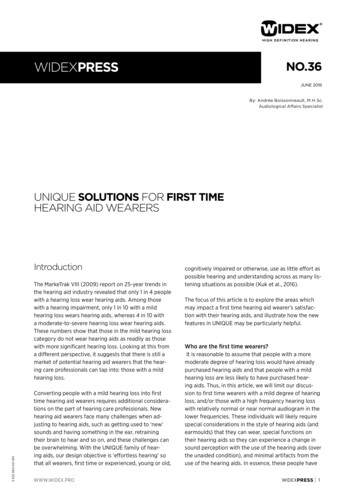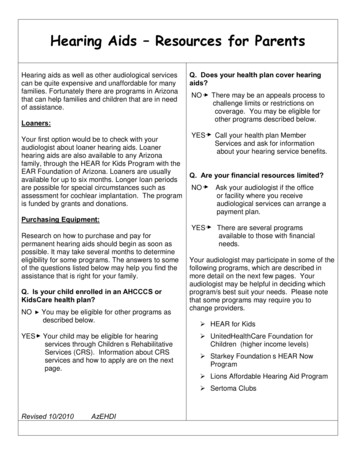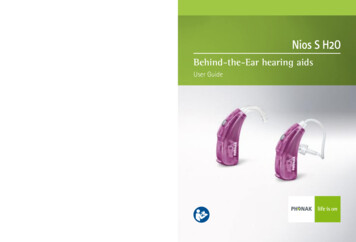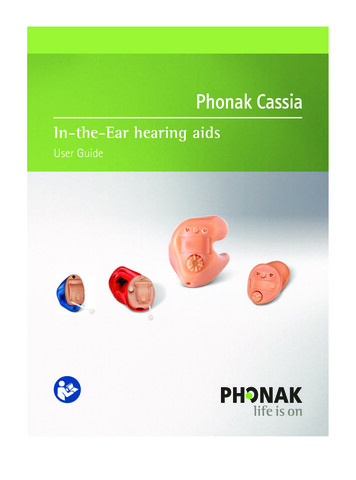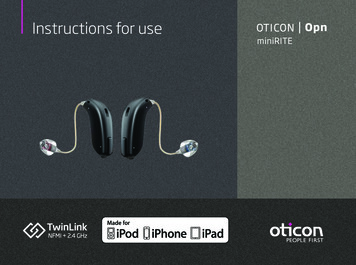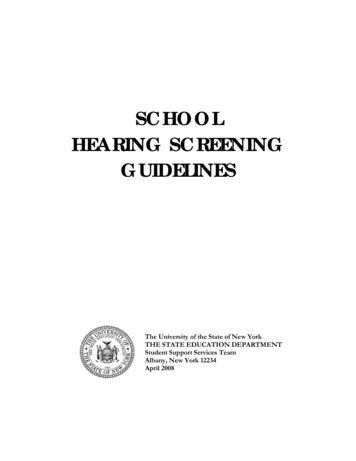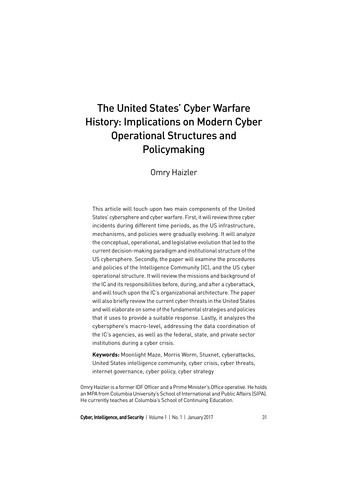
Transcription
PA Cyber School Hearing, August 14, 2019Testimony of Dr. Gerald ZahorchakGood afternoon, Chairman Langerholc, Chairman Dinniman, and esteemed members of the SenateEducation Committee. Thank you for the opportunity to testify before you today on charter and cybercharter schools.In April of 2009, I was in the position of Secretary of Education for Pennsylvania, and I testified beforethis Committee and I noted: “For too long, every discussion of charter schools in Pennsylvania has beenframed as a debate between those who are “for” charters and those who are “against” them. The timehas long passed for such unhelpful distinctions.” During the previous testimony, I stated that “ morethan a decade after the passage of Pennsylvania’s charter school law – charters have become anestablished component of the public education landscape.” In 2009, across the Commonwealth, 127charter schools were serving 67,000 students. I noted that our Administration supported “every school –district-operated, charter or cyber charter – that provides a quality education to its students.” Today, in2019, a decade later, support for all public schools, regardless of structure, has begun to change,primarily due to legislation that is too permissive with regard to costs, special education, andprivatization.The state has compiled updated data on the number of charters and students served by charter types;performance data; cost data; and information regarding issues like special education and privatecompanies desire for monetary gains from public charters. I wish to testify primarily on these data andissues as related to Cyber Charters.Charters and their studentsIn the 2018-2109 school year, which ended June 30, 2019, the commonwealth’s K-12 education systemserves more than 1.7 million students. Pennsylvania’s 500 school districts range in size fromapproximately 200 students to more than 140,000 students. In addition to school districts, there aremore than 160 brick-and-mortar charter schools and 14 cyber charter schools are responsible foreducating 135,000 students, an increase of approximately 65,000 more students in charter whencompared with the 2008-2009 enrollment numbers cited. More than 33,000 Pennsylvania studentsattend cyber charter schools, which is nearly 25% of all charter students.In 2010 approximately 300 million represented the costs of charter schools in Pennsylvania; and today,those cost have soared to 1.65B, almost 6 times as much, a 600 percent increase.Performance of cyber charter schools in PennsylvaniaIn July of 2019 on Smart Talk, Associate Producer, Benjamin Pontz, wrote the following about CyberSchool Performance, “cyber charter schools tend to have poorer educational outcomes than theirpublic-school counterparts, research from both the Pennsylvania Department of Education and theCenter for Research on Education Outcomes (CREDO) at Stanford University shows ("Performance of cybercharter schools in Pennsylvania", 2019). A comprehensive assessment on charter school performance inPennsylvania released earlier this year found that students in cyber charter schools lag "dramatically"behind their peers in both traditional public schools and in brick-and-mortar charter schools when itcomes to performance in reading and math.”1
In a June 2019 piece published by Brookings, authors David Baker and Bryan Mann noted that“Pennsylvania school districts are at the epicenter of the cyber charter school phenomenon [with]enrollments in Pennsylvania among the largest nationally (Barker and Mann, 2019).” The authors notethat only Pittsburgh and Philadelphia have enrollments larger than the 33,000-plus students enrolled inthe state’s cyber schools.Legislation Compared NationallyFrom a national perspective in a 50-State Comparison (January 2018), the Education Commission ofStates, found six states do not permit charters of any type; of the 44 that do permit charters, 22 do notallow virtual charters. Thus, 26 of 50 states do not permit cyber charter schools at all. Of the 24 that dopermit them, Pennsylvania’s current legislation seems to have the least amount of accountability andthe only illogical funding system. Ohio, Pennsylvania, and California are the “big three” when it comes toenrollment in full-time virtual charter schools. According to National Alliance for Public Charter Schools’June 2016 “A Call for Action” research, “enrollment in full-time virtual charter schools is highlyconcentrated in three states – Ohio, Pennsylvania, and California – which collectively enroll over half offull-time virtual charter school students nationwide.” (Education Commission of States, 2018)Costs of PA Charter SchoolsAccording to Temple University’s Center on Regional Politics, Policy Brief, in a January 2019 report titled“A Tale of Haves and Have-Nots: The Financial Future of Pennsylvania School Districts,” authors Drs.William Hartman & Timothy J. Shrom noted that Charter School costs “will place an increasing burdenon school district taxpayers as the state does not support these mandated district costs. Charter SchoolTuition is the second largest increase of any of the major expenditure categories, second only toSalaries, and more than PSERS, Health Care and Other, or Net Other Expenditures. The annual increasein district costs is estimated to rise from 116 million in 2017-18 (15% of total annual increases) to 152million (21% of total annual increases) by 2021-22, yielding a five-year increase of 666 million (19% oftotal five-year increases). This is in addition to existing tuition payments from districts of 1.65 billion in2016-17, which would raise the burden on taxpayers and school districts’ budgets to 2.3 billion by2021-22. One out of every five district taxpayer dollar increases will be used to pay Charter SchoolTuition.” Charter schools’ costs will total, according to the report, 2,321,213,034: a 666,220,221 or40.3% five-year increase (Hartman, Shrom, 2019).The online education programs, cyber charter, are public schools and receive millions in state fundingeach year, money that comes from the budgets of the public-school districts in which the cyber charterstudents reside. In 2006-07, cyber schools received about 150 million in total funding from schooldistrict; that number has grown dramatically, consider the following Annual Financial Reports submittedto PDE by the Cyber Charter Schools for the year 2017-18 (Pennsylvania Department of Education) .Cyber Charter Name:21st Century Cyber CSAchievement House CSACT Academy Cyber CSAgora Cyber CSASPIRA Bilingual Cyber Charter SchoolAFR Revenues 2017-18 14,931,988 8,638,840 1,775,845 96,499,879 5,991,9252
Central PA Digital Learning Foundation CSCommonwealth Charter Academy CSEsperanza Cyber CSInsight PA Cyber CSPennsylvania Cyber CSPennsylvania Distance Learning CSPennsylvania Leadership Charter SchoolPennsylvania Virtual CSReach Cyber CSSusq-Cyber CSTOTAL REVENUE 2,582,920 129,688,433 23,605,904 10,865,359 150,886,775 12,394,100 43,211,490 31,080,924 26,663,094 1,076,511 559,893,987Cyber costs are different and far lessThere is abundant evidence when comparing “district-run cyber programs” to existing cyber charters toestablish the fact that districts are paying far too much in basic and special education costs to cybercharters. As stated in the Hartman and Shrom report, supra, districts are having a tough time financially,which will grow worse in time, in terms of keeping up with salaries, retirement and health care costs, tobe burdened by a mandated cyber expenditure. A mandate that is allowed to persist in spite of theknown difference between costs of the regular (brick and mortar) charters and cybers.Cyber schools and “brick and mortar” charters are vastly different financially, however, the paymentsystems of the mandates for cybers and brick and mortar are exactly the same. The school district ofresidence for each charter student is required to pay the charter a per-s’student rate based on theschool district of residence’s own costs for regular or special education determined/certified by thePennsylvania Department of Education.As an illustration, consider two school districts sending one child each, whose background and needs arevery similar, requiring the same “educational programing,” to the same charter school. These twostudents would attend the school at two very different tuition costs. This hard-to-understanddilemma—different costs for the same product-- is the same for a “brick and mortar” charter. Forexample, consider the incredible variation in school district tuition rates. In 2017-18, state-certifiedtuition rates for school districts ranged from a low of 7,598 for students from Steelton Highspire SchoolDistrict to a high of 18,553 for students from New Hope-Solebury School District. A cyber charterschool that enrolled a student from each district would bill their taxpayers a different tuition amount forthe same education. The tuition-cost structure is not logical and certainly not innovative.The same illogical funding structure is applied to each district’s special education state-certified tuitionrates. Some students enter the cyber school as at a basic education rate and then are determined to bedisabled, which then the special education tuition applies. The range for special education tuitionbegins with Bellwood Antis SD at 15, 119 (Richland SD is 15,334) to Lower Marion at 48,198. Thosenumbers are higher for the 2018-19 school year (yet incomplete for all districts); Lower Marion is listedat 53,756. These costs are much less expensive when the districts operate their own cyber schools.3
In a TribLive, Feb. 2019 article by Deb Erdley: “Norwin School District Superintendent William Kerrconcedes there are valid reasons why families might prefer cyber schools, including serious medicalissues and a preference for a cyber learning environment Nonetheless, Norwin tries to steer families toits district cyber academy where the cost for a fulltime student is 2,680 a year, compared to 9,741(PDE certified tuition rate for Norwin) a year for those who attend cyber charter school.” (Erdley, 2019)In the same article, former executive director of the Pennsylvania Association of School BusinessOfficials said, “Much of the concern expressed by school districts stems from the way cyber charterschools are funded.” (Erdley, 2019)“A 2011 study of online learning cost by the Thomas B. Fordham Institute estimated the average perpupil cost for a full-time virtual school is 6,400 [including special education services,” as referenced inthe National Alliance for Public Charter Schools “A Call to Action” report (A CALL TO ACTION TO IMPROVETHE QUALITY OF FULL-TIME CYBER CHARTER SCHOOLS). Pennsylvania’s uneven tuition structure is, again,not logical and not innovative.Innovation was the expectation for related to the creation of charter schools, and in the case of cybers,the innovation provides a potential solution for options within public education. The intent of theoriginal legislation was for school districts to learn from and replicate good practices from the charters.In the case of cyber charters, this seems to be the case, considering many school districts havedeveloped their own cyber charter school or cyber school program. Many existing cyber schools werecreated by school districts and are run by the school districts’ Intermediate Units. In the cases wheredistricts have their own cyber school, the districts are spending far less than the PDE certified, illogicaltuition payments. Often the difference represents a 50% or higher savings to the district.The House Bill offered by Representative Rep. Curt Sonney (Palochko, J. 2019), the Chair the HouseEducation Committee, seems to represent a consensus among educational leaders throughoutPennsylvania. The Bill would mandate that if a district had its own cyber school, then parents wouldhave that school as their only option. One might assume the Bill potentially could return approximately 225 Million dollars back to the school districts.Special Education in Cybers present additional issuesThere are examples of good cyber charter practices for some students with certain abilities or disabilitieswhere cyber education can be “a godsend.” (Barker and Mann, 2019). I personally recommended the K12Inc. well-resourced online curriculum for a student with Down’s syndrome whose parents wanted theirchild to be educated in the home. One of the child’s parents was determined to be constantly in thehome-learning environment with the child. In that case, the parents and the child rated their experiencewith high marks. However, I have witnessed too many students who fail to meet the expectations forparticipating online and then fail to keep pace with their same-age cohort of students. Often, thesestudents returned to their school district without completing requirements for promotion; this wasespecially true for high school students who failed to acquire the credits necessary to advance to thenext grade level.4
For most students, cyber charter schools do not appear to be performing well. According to theBrooking’s article referenced previously, “researchers, state departments of education, and investigativejournalists conclude that these [cyber] programs are not performing well academically particularlydisadvantaged ones.” In the “Call to Action,” supra, “Full-time virtual charter schools serve a higherpercentage of students in poverty [nationally] (48 percent vs. 39 percent), a significantly lowerpercentage of English-language learners (1 percent vs. 8 percent), and a slightly larger percentage ofspecial education students (11 percent vs. 8 percent) than traditional public schools.”Beyond the cyber schools’ overall performance and who they serve, there are issues related specificallyto special education starting with the current cyber charter school funding formula for specialeducation; then there is the issue regarding the high percentage of provision of special educationservices to certain disabilities and low percentage for others.The formula used does not rely on actual costs for educating the students with disabilities in cybercharter schools, which ends up costing local districts more. Further, the formula seems to have thepotential to perversely reward increasing the number of students with school entity determinedexceptionalities. For example, in the three largest Pennsylvania cyber schools, the percentages ofstudents with special needs far exceeds the state’s averages. When taken together, those three systemsenrolled 24,432 students during the 2017-18 school year (representing about three quarters of all cyberstudent enrollment); 5,423 were enrolled as special education students. The state’s Percent SpecialEducation is 16.9% and collectively the three cybers with the largest enrollments is at 22.25%(approximately 76% higher special education enrollment when compared to the state’s specialeducation enrollment numbers) (Special Education Data, n.d.).Further, it appears that the three high enrollment cyber charters enroll, at a much higher percentagelevel, students who have Emotional Disturbance and Specific Language Disabilities (two categories thatseemingly are often given to students in systems with poorer whole school academic or behavioralprograms; students who, again seemingly, may not actually have a disability that is organic). In 2002,the Presidents Commission on Special Education reported “Of those with ‘specific learning disabilities,’80 percent are their [in special education] because they haven’t learned how to read it is the area thatresulted in their special education placement.” (President’s Commission on Special Education, 2002.(2002) The three systems have a range of two to four percentage points higher enrollment in EmotionalDisturbance; and four to seven percentage points higher in Specific Learning Disability category. Thehigher percentage of special education enrollment results in significantly higher dollar amounts intuition paid by school districts per student. As previously cited, for example, Lower Marion pays aspecial education rate of 53,756 per student, which is well above the costs for the non-specialeducation rate.Enrollment Criteria NeededBeyond the issues of special education, the National Alliance for Public Charter Schools Report, supra,recommends “Enrollment Criteria.” While maintaining the principle that all students must be served,the authors note that “full-time virtual charter schools are not a good fit for many children and thatsolely relying on self-selection in enrollment process isn’t working operators appear to havedeveloped programs that are only designed to be effective with self-motivated students and/or studentswith highly involved parents [like my friends’ story included in this testimony].“ I believe as onerecommendation, the state should examine the data related to students who succeed in a cyber5
environment and those who do not. The examination would analyze student tendencies, characteristicsof successful students, and the findings would be used to develop the creation of enrollment criterialegislation. Perhaps, alternatively, an approach to develop enrollment criteria could be as simple as atrial period, and for students who are not attending/participating or who participate and demonstrateno real effort, the program would be disallowed.Summary and Additional RecommendationsTo summarize, my testimony was provided to present ideas for legislation, along with updated data onthe number of charters and students served by charter types; information of performance data; costdata; information regarding other issues, e.g. special education; and a recommendation for enrollmentcriteria.Thank you, Senators, for your earnest interest in examining this issue.Cyber charters will remain an option for public school students in our state, which is a state with anabundance of choice within public schools, e.g., four-year old programs, Dual Enrollment, AP Courses;Career and Technical programs, and more.It seems to be the general consensus among elected lawmakers that the cyber school funding formulafor regular and special education services must become more realistic, especially in light of the contextprovided by Hartman and Shrom, supra. There are opportunities to join Intermediate Units andTraditional schools to provide enhancements to the quality of programming and solutions to the fundingand other issues. The step to fix the formula will financially aid all school districts and will be a small stepin the right direction, and the easiest fix, as the state responds to the school funding problems that existand are predicted to become worse.I thank you Chairman Langerholc for your consistent and good care for public education; I also thankChariman Dinniman for the same leadership. Members of the Committee, thank you for permitting meto provide testimony and for your concern for public education.References:A CALL TO ACTION TO IMPROVE THE QUALITY OF FULL-TIME . (n.d.). Retrieved fBaker, D., & Mann, B. (2019, June 24). Do cyber charter schools harm public education for the mostdisadvantaged? Retrieved from blic-education-for-the-mostdisadvantaged/Center on Regional Politics. (2019, January). Retrieved from dent's Commission on Special Education, 2002. (2002) Retrieved August 2019, fromhttps://www.iris.peabody.vanderbilt.edu6
Palochko, J. (2019, March 03). Proposed law could save Pennsylvania school districts money, but be'death knell' for cyber charters. Retrieved from .htmlPerformance of cyber charter schools in Pennsylvania. (2019, July 15). Retrieved Resource Title:50-State Comparison: Charter School Policies. (2018, January). Retrieved ecial Education Data Reporting. (n.d.). Retrieved July/August, 2019, ry of Annual Financial Report Data. (n.d.). Retrieved July/August, 2019, fromhttps://www.education.pa.gov/Teachers - Administrators/School Finances/Finances/AFR DataSummary/Pages/default.aspx7
8
to PDE by the Cyber Charter Schools for the year 2017-18 (Pennsylvania Department of Education) . Cyber Charter Name: AFR Revenues 2017-18 21st Century Cyber CS 14,931,988 Achievement House CS 8,638,840 ACT Academy Cyber CS 1,775,845 Agora Cyber CS 96,499,879 ASPIRA Bilingual Cyber Charter School 5,991,925

